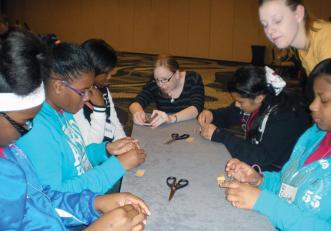A Passion for Teaching Physics
Spring
2014
Special Feature
A Passion for Teaching Physics
SPS Outreach Inspires a Student to Become a Teacher
By:Cristian Bahrim, Associate Professor of Physics, Lamar University, Beaumont, TX
Robert Holman discovered his love for teaching in early 2010 while standing in front of a classroom of fifth and sixth graders at Pietzsch-MacArthur Elementary School, located just a few blocks from Lamar University. Robert was then an undergraduate at Lamar, and this was his first experience presenting to children of such a young age. He was worried about delivering the information in a way they could understand and enjoy, but he got over his nervousness and was soon caught up in their enthusiasm.
“I was reminded of myself at their age, watching what I thought was magic,” Robert later told me. “I hope to have lit the same flame in them that Mr. Wizard put in me.” Mr. Wizard hosted a children’s television program about science, filmed in the 1950s and 1960s, and watching reruns inspired Robert’s interest in physics when Robert was in middle school.
 Many students in our physics program have developed an interest in teaching physics while participating in outreach. Robert’s story is one of the most unique. After he joined Lamar in the spring of 2003, he tried out eight different programs over the course of six years—leaning toward an English degree at one point—before deciding in 2009 to become a physics major. He was then accepted to a National Science Foundation–sponsored program at Lamar called STAIRSTEP, which supports low-income students who are minorities and the first in their families to attend college. This program helps these students graduate with a BS degree in a science, technology, engineering, and mathematics (STEM) discipline. Robert excelled in the program; he had an immense love for sharing knowledge with others, an exceptional humor, and a talent for making physics fun.
Many students in our physics program have developed an interest in teaching physics while participating in outreach. Robert’s story is one of the most unique. After he joined Lamar in the spring of 2003, he tried out eight different programs over the course of six years—leaning toward an English degree at one point—before deciding in 2009 to become a physics major. He was then accepted to a National Science Foundation–sponsored program at Lamar called STAIRSTEP, which supports low-income students who are minorities and the first in their families to attend college. This program helps these students graduate with a BS degree in a science, technology, engineering, and mathematics (STEM) discipline. Robert excelled in the program; he had an immense love for sharing knowledge with others, an exceptional humor, and a talent for making physics fun.
A couple of weeks after his experience at the elementary school, Robert and three other physics majors assisted me in delivering a one-hour science demo in front of about 200 high school science teachers, at a conference organized by the Science Teachers Association of Texas. The event was a big success. In Robert’s words, “that day I left, as did all in attendance, in awe.”
Later, Robert participated in an on-campus visit of students from Warren High School. His demonstrations about light—which were followed by clear, simple explanations about the physics involved in the interaction between light and matter—captivated the 26 student visitors and their teacher. Robert had a genuine interest in optics that extended beyond outreach. He performed good research in the field, and says that presenting his work at a student conference organized by the Texas Academy of Sciences was the defining moment in his life, one that tied his future to physics.
After graduating from Lamar, Robert received a job offer from the Ross Sterling High School in Baytown, near Houston, Texas, as well as four other offers for nonteaching jobs. He finally decided to become a physics teacher and continue sharing his love for physics with younger students—thanks to his experiences with outreach at Lamar. “Teaching and demonstrating physics in community outreach in the program moved me to become a high school physics teacher,” says Robert, who again demonstrated his talent for inspiring students of all ages during his recent visit with students in the STAIRSTEP program. A conversation with Robert inspired current undergraduate Logan Talbert to want to be a physics teacher. //
Interested in Science Teaching?
The American Association of Physics Teachers (AAPT) is a professional membership association of scientists dedicated to enhancing the understanding and appreciation of physics through teaching. AAPT members include physics teachers at the high school, undergraduate, and graduate level and students interested in teaching. AAPT is a Member Society of the American Institute of Physics, home to the Society of Physics Students. This means that undergraduate SPS members can receive free membership in AAPT when they join or renew their membership. For details, see www.spsnational.org/about/benefits.htm.
